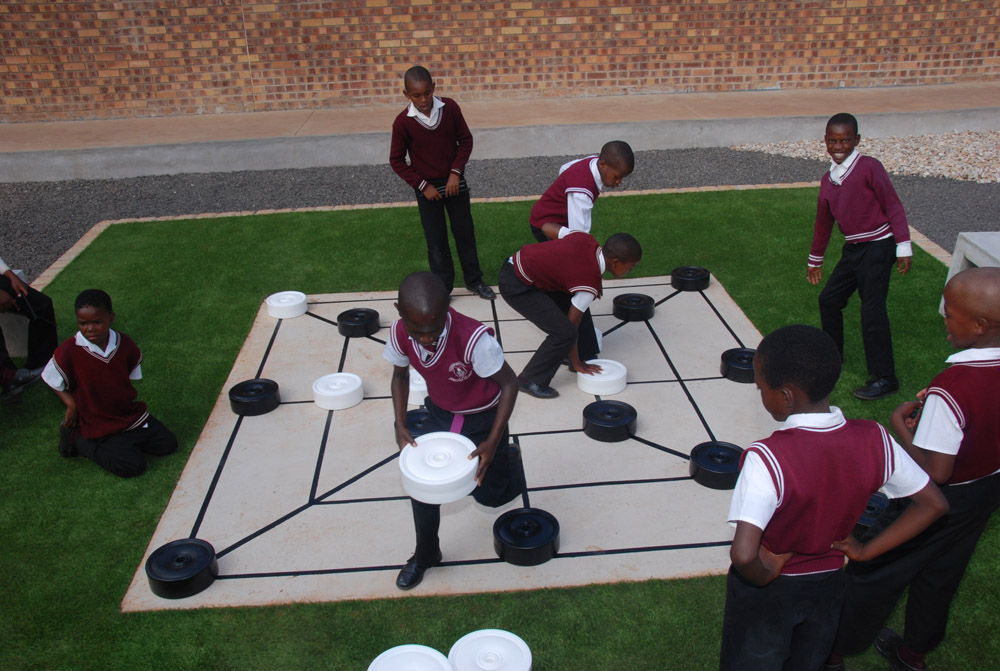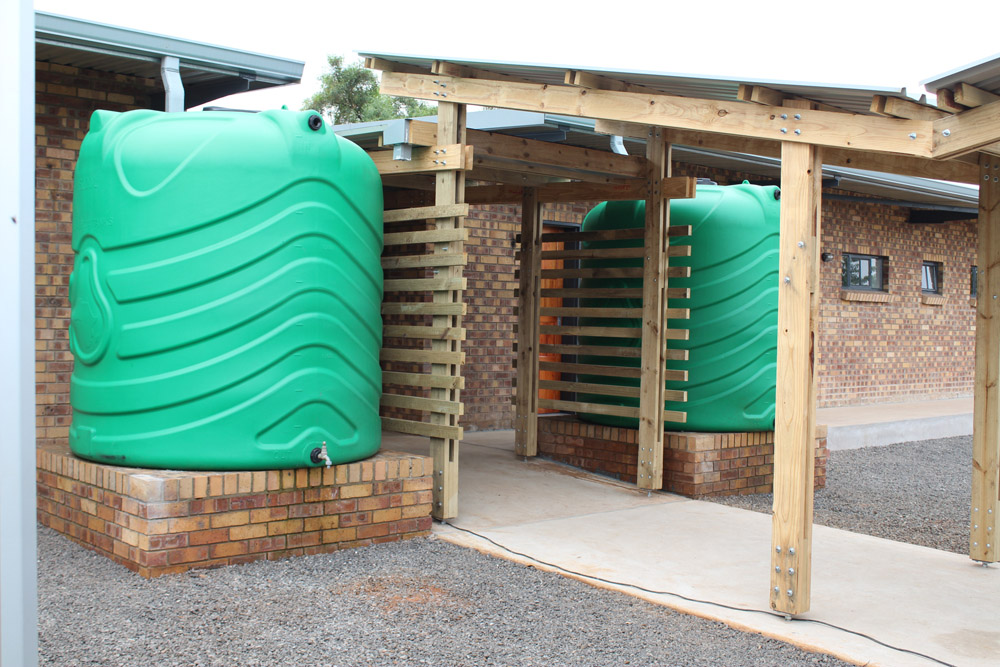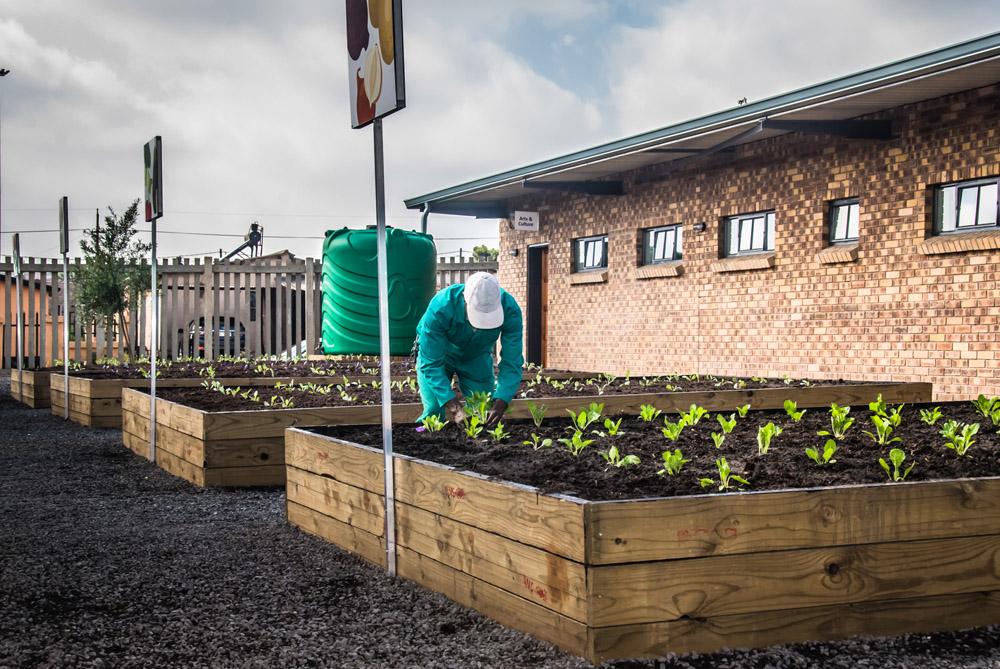On January 23 an upgrade project handover ceremony was held at Thushanang Primary School in Mhluzi, Middelburg, in Mpumalanga.
For the past five years, General Electric (GE) has been working with local municipalities and supporting schools in Mpumalanga through its school infrastructure upgrade projects.
 Tushanang learners playing chess in newly built recreational area. (Photo: Howling Hound Photography)
Tushanang learners playing chess in newly built recreational area. (Photo: Howling Hound Photography)
GE works collaboratively with customers and helps countries improve access to reliable power by harnessing local energy resources, as well as implementing innovative power generation technologies to reduce environmental impact. It generates nearly one-third of the world’s power: more than 1600 gigawatts of electricity in 140 countries.
The project at Thushanang began in January 2018 and will benefit more than 1 000 learners.
Project manager Aadil Peer recalled his first encounter with principal Thabang Tshehla and staff members in his address: “What the team and I saw when we first came here was unbelievable. There was dilapidated infrastructure with asbestos and electric wires exposed. What was even more concerning was that were learners receiving lessons in classrooms with no electricity. The kitchen was not even constructed — it was something I had never seen in my life before.
“It was clear that something needed to be done. We committed ourselves on the very same day. On our second visit, we came with architectural designs to present to the principal and I clearly remember the excitement and smiles on the teachers’ faces. We made a promise; today we have delivered,” said Peer.
 The landscaping of the school
The landscaping of the school
Project scope of work
The school project upgrades included the following:
- Demolishing and safe removal of existing asbestos classrooms and toilets
- Construction of 20 classrooms
- Construction of a new kitchen with feeding area
- Construction of two ablution blocks
- Stormwater control and rainwater harvesting
- Parking space and drop-off area
- Vegetable garden for educational and nutritional purposes
- Games and activities for enhanced recreational experience
- Supply of equipment and furniture
- Tuckshop
Job creation and skills development
Pegasus Civil Construction was responsible for all construction upgrades and sub-contracted 19 local SMMEs. A total of 168 jobs, including 66 for youths, were created on the project site, and 123 accredited skills development trainings were provided.
GE’s project director Paul Collins said they had partnered with their customer, Eskom, on the project. “The power utility also visited the school to evaluate the premises and see what they could offer. We were focussed on removing the asbestos and ensuring that we give back to the community. The construction took 12 months to complete. We made sure that we created a unique environment complimented with an infrastructure that will last for decades.”
Tshehla expressed his joy and described the project as “a dream come true” after teaching for seven years at the school in appalling conditions. He said there were challenges from the community when appointing sub-contractors, but it was nothing the school could not handle.
“It is the official handover today, and we are delighted. I must point out that there are no casualties that I know of since I’ve been in the school. We know that asbestos poses a health hazard, but it is all gone.”
Children’s lungs and respiratory systems are still growing. Their lungs have a higher surface area to volume ratio than the lungs of adults. Children breathe at a faster rate, meaning they can inhale more asbestos fibres. They can accidentally ingest the fibres if they put their fingers in their mouths and have come into contact with asbestos particles. The fibres can cause a rare, hard to diagnose asbestos-related cancer that develops in the omentum, a membrane that covers the digestive organs.
“The school is definitely heading in the right direction, as we have also introduced hockey and cricket. At the moment we do not have the facilities for them, but we will make use of the field that is available and develop these new sporting codes,” noted Tshehla. The school governing body’s chairperson, Piet Masemola, shared the same sentiments.
 Jojo tanks for rainwater harvesting
Jojo tanks for rainwater harvesting
Development programmes
Mpumalanga’s education MEC, Bonakele Majuba, said: “This handover’s timing is perfect, as the province has just achieved an 80.3% matric pass rate. I commend the public-private partnership and I’m convinced that through these infrastructure development programmes, it will add value to overall learning and teaching. Learners must take care of this school because it’s not just a building, but a centre of learning and development. They must guard it jealously, like it’s their own property.”
He emphasised that public-private entities have the interest of the people at heart, and said the project is a “courtesy call” to encourage and inspire the learners, youth and the community at large. He said as much as the Constitution of South Africa guarantees access to education, it is important that every learner fulfils their duties.
Other schools that were adopted by GE for the infrastructure project in the province include Dunbar in eMalahleni, Somabedlana in Katjibane, Mafa Max Secondary School and Swartklip Combined School in Delmas, and S’bongile School in Matsulu.
 Vegetable garden built for educational purposes. (Photo: Howling Hound Photography for Premier Aviation)
Vegetable garden built for educational purposes. (Photo: Howling Hound Photography for Premier Aviation)
Through the projects, 10 schools have been refurbished and upgraded to date. The projects take the environment into consideration, implementing ecologically-conscious solutions such as rainwater harvesting, energy efficiency fittings, enviroloo water-free toilets and low maintenance landscaping. This has enabled a better and more productive learning and teaching environment.